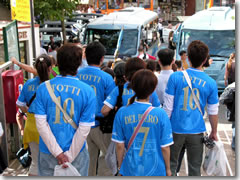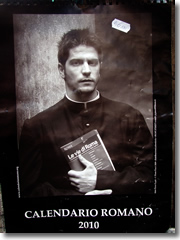- Places
- Plans
- Itineraries
- Experiences

An Italian team soccer shirt (Forza Azzuri!) is a great non-tchockie souvenir—just don't everyone in your group wear them on the same day. (Notice something weird: the men all have Totti shirts, the women Del Piero.)Make sure you know the local going rate on items you think you may want to buy before you leave home. This way, you'll know whether you're actually getting a bargain by buying it abroad.
The famous shopping street or neighborhood in any city—Via dei Condotti in Rome , the Quadilatero d'Oro in Milan, Via de' Tornabuoni in Florence—offers some of the best window shopping, but be prepared to drop a huge chunk of change if you want to purchase anything. You may find the same item in another shop on a lower-rent street for less.
Also, bring your camera; markets make for colorful visual memories.
If it's at all expected in a given situation, always haggle (more on that on the "How to Bargain" page). » more
I know; I get paid to come up with brilliant stuff like that. Prices vary dramatically from shop to shop, stall to market stall, and they usually vary inversely with their distance from any major tourist sight. Let the store owners know you're comparing prices, and the asking rate may go down on the spot.
There are bargain-basement fashion outlets in European fashion capitals, of course, but they usually offer no better deals than you'll find in the United States. Of course, there's always that cachet of having bought those shoes in Florence or that dress in Milan.
Don't gobble up every trinket you see. Go for the items that truly bring out a destination's spirit, style, or culture. It may be a beautiful museum book, hand-painted ceramics, delicate leather gloves from Florence, a compilation CD of the greatest (local) pop hits of the year (a personal favorite of mine), a crèche scene from Naples, or a kitschy blown-glass figurine from Venice. Just make sure it's memorable to you.
You could buy twice as much in Apulia as you could in Milan or Venice for the same money.
Be sure any DVDs or videotapes you purchase are in U.S. format, because you can't view European vids on a U.S. machine (they're encoded differently to try to staunch piracy, which is ridiculous since it's so simple to rip DVDs, but there you go). Most recorded media at tourist sights are available in many formats:
For DVDs, if you expect to be able to play it in the U.S. or Canada, you need to buy a "Zone 1" (not "Zone 2," which only work in Europe, Japan, South Africa, and the Middle East) or "Zone 0" (which are "zoneless" and hence can be played anywhere).
For video tapes, you want to buy NTSC format (not PAL).
On most escorted tours, the guide will take or direct you to shops that offer "special prices" to people on your tour. Ninety percent of the time, the shop is feeding the guide a kickback. (Guides are so scandalously underpaid, this is often the only way they can scrape by.)
Usually, the store passes this percentage along to you by jacking up the prices. Although some guides do give honest recommendations, and even some of those kickback arrangements don't adversely affect you via markups, it's impossible to know when a recommendation is on the level. I'd take the cynical route and ignore any guides' suggestions.
Show that (or look like) you know what you're doing. Shopkeepers who see a savvy customer are less likely to try to pull the wool over your eyes—even when you're trying on sweaters.
You want merchants to know you're a paying customer and not tourist riffraff who's just window shopping, but you don't want to give them the idea that you're loaded with cash, either. Prices will go up on the spot if they think you're capable of paying them, especially in markets but even in stores.
If your budget and plans are going to allow you to spend near or over that amount, try to do all your shopping in one store so you can get that refund—it's like getting an automatic 20% (or so) discount. » more
Also, make sure the receipt is complete and accurate. Don't be rude about it, but make sure you haven't gotten a rotten shopkeeper who's trying to scam or shortchange you. » more
The receipt is important, not only because you will need it for any VAT refund, but in Italy it is the law. You must carry your receipts for any purchase (even a slice of pizza) away from the store with you at least 200 meters. This has to do with the Italian government trying to foil tax cheats, but the law affects you as well.
Both you and the merchant can be fined if you have no receipt and are stopped by the a member of the Guardia della Finanzia (the "Finance Guard," who walk around town like beat cops, with uniforms with guns and everything; before you laugh, remember this: Elliot Ness, who took down Al Capone, and the Secret Service agents who guard the president all work for the American version of the same thing, the U.S. Treasury Department).
This law, by the way, is why Italian merchants are always so curiously keen to make sure you retrieve your receipt, often calling after you urgently and waving it around to make you come back and get it. This puzzles most Americans, who are used to strolling away from a register and letting the cashier toss the slip of paper, but is a godsend to those of us who need to gather receipts for expense account or tax purposes.
It may cost a bit more, but the longer you keep your more fragile purchases with you bouncing down the road of your trip, the greater the chances that your Venetian glass souvenir will end up Venetian glass shards.
You can save yourself time and hassle should something go wrong with a purchase being shipped home if you snap a photo of your purchases before they're wrapped up.
This photo makes excellent proof of purchase when it comes to insurance claims. If you find that you're running out of room in your luggage, ship those fragile items home first, then mail home your personal stuff you don't need, like dirty laundry, rather than entrusting all your purchases to the postal system.
Wander the aisles of a supermarket, hardware store, or the local equivalent to Target, checking out an Italian's daily essentials.
Instead of just bringing home mantelpiece tchotchkies, return with souvenirs you'll use in everyday life.
Pick up a brand of toothpaste you’ve never heard of.
Purchase some typical Italian housewares—find a kitchen store or hardware store and grab one of those cheap, thick glass half-liter carafes in which your wine has been served at every little trattoria, or a pasta-drying rack, or that classic octagonal hourglass stovetop espresso maker by Bialetti.
I have "no smoking" and "beware of cat" signs in Italian (and a variety of other foreign languages).
If you’re a music fan, pick up CDs by Italian pop groups. I look for compliations—very popular in Italy—so as to get a good mix of bands and styles. (The annual Sanremo Festival compliations are good, balancing esatblished musicians with newcomer acts; Festivalbar was good, too, but sadly the festival ceased in 2007.)
I must have 200 Italian pop albums. On my shortlist of personal favorites: Nek (earnest 90s pop), 883/Max Pezzali (electronica pop; Pezzali went solo in 2003), Vasco Rossi (70s/80s rock), Ligabue (80s rock), Jovanotti (experimental/poetic rock freely mixing world, hip-hop, and pop influences), Eros Ramazzotti (90s pop crooner), Zucchero (80s rock), Lucio Dalla (70s/80s rock), Pino Daniele (singer-songwriter).
(My iPod is also crammed with songs I can't for the life of me sing along to—and, in the case of those written in Arabic and Chinese, can't even figure out the name of the band—but I really dig the sounds.)

You can't tell me you don't know someone who would be positively delighted to get this souvenir calendar of hot young Italian priests.Bring home real mementoes of your trip and of the destination, not ready-made and mass-produced memories. Shop flea markets and the local equivalent of a K-Mart and take home some of those everyday objects that you only find in their home countries.
Get a Cave Canem ("Beware the Dog") sign in Latin from Pompeii (its a famous mosaic there), or pop into a hardware store to pick up one of those lopsided hourglass-shaped carafes they use to serve table wine in osterie.
That way, instead of going in a shoe box or display case once you get home, your souvenirs become part of your daily routine, and every time you open the back gate or have wine with dinner, you have a reminder of that great Italian vacation.
Share this page
Search ReidsItaly.com